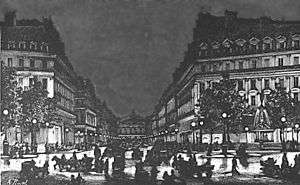Yablochkov candle

| Wikisource has original text related to this article: |
A Yablochkov candle (sometimes electric candle) is a type of electric carbon arc lamp, invented in 1876 by Pavel Yablochkov.
Design
A Yablochkov candle consists of a sandwich of two long carbon blocks, approximately 6 by 12 millimetres in cross-section, separated by a block of inert material such as plaster of paris or kaolin. There is a small piece of fuse wire or carbon paste linking the two carbon blocks at the top end. The assembly is mounted vertically into a suitable insulated holder.
On application of the electric supply, the fuse wire 'blows' and strikes the arc. The arc then continues to burn, gradually consuming the carbon electrodes (and the intervening plaster) as it does so. The first candles were powered by a Gramme machine.
Electrodes last about two hours or until the power is cut. A classic Yablochkov candle cannot be relit, since the fuse wire between the electrodes has been consumed. Later versions of the candle, however, included powdered metal in the inert separator. This would act as a new fuse wire, allowing a half-burnt candle to be restarted once extinguished.
The advantage of the design over other carbon arc designs is that it removes the need for a mechanical regulator to maintain the appropriate distance between the carbon blocks to sustain the arc.
History
It was first demonstrated as street and theatre illumination during the Paris Exhibition of 1878, notably on the Avenue de l'Opéra. The candles were enclosed in globes of enamelled glass, with four to twelve candles in each connected in series. (See also Pavel Yablochkov)
Gallery
-

Yablochkov candle without bulb. Illustration from La Nature (1877).
-

Yablochkov candles illuminating Avenue de l'Opéra in Paris under the Exposition Universelle (1878).
-

Yablochkov candles in Music hall at Place du Château d'Eau in Paris, c. 1880
-

Yablochkov candles installed at Victoria Embankment in London, December 1878